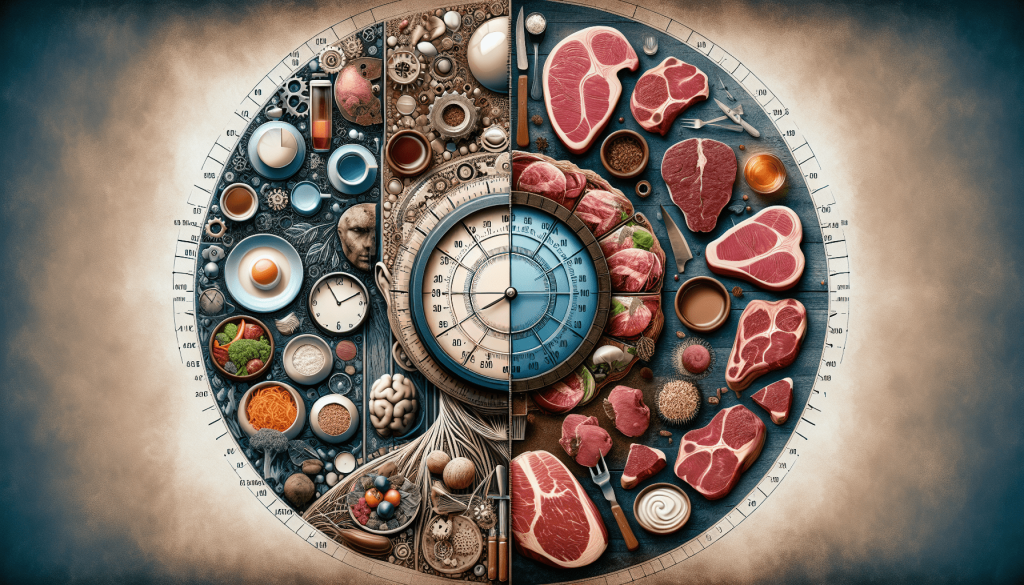So, you’ve heard about intermittent fasting and the carnivore diet but aren’t sure how they go hand in hand? Look no further because this article has got you covered! We will be exploring the concept of intermittent fasting and how it can be successfully incorporated into the carnivore diet. From the benefits to the different approaches, you’ll have all the information you need to kick-start your journey towards a healthier lifestyle. So, grab a cuppa and get ready to become an intermittent fasting pro on the carnivore diet!

What is the Carnivore Diet?
Definition of the Carnivore Diet
The Carnivore Diet is a dietary approach that emphasizes the consumption of animal products while eliminating all plant-based foods. It is a zero-carbohydrate, high-fat, and moderate protein diet that promotes the exclusive consumption of meat, fish, eggs, and dairy products.
Principles of the Carnivore Diet
The Carnivore Diet is based on the principle that our bodies evolved to thrive on animal-based foods. Advocates of this diet believe that humans have been eating meat for thousands of years and that it provides all the essential nutrients our bodies need. The main principles of the Carnivore Diet include:
-
Elimination of all plant-based foods: The Carnivore Diet excludes carbohydrates and plant-based sources of food, such as fruits, vegetables, grains, legumes, and even nuts and seeds.
-
Focus on animal protein and fat: The diet centers around consuming high-quality animal products, including meat, poultry, fish, eggs, and full-fat dairy. These foods are rich in essential nutrients such as vitamins, minerals, and healthy fats.
-
Limited or no supplementation: Supporters of the Carnivore Diet argue that consuming a wide variety of animal foods can provide all the necessary nutrients, thus eliminating the need for supplements.
Introduction to Intermittent Fasting
Definition of intermittent fasting
Intermittent fasting is not a diet, but rather an eating pattern that cycles between periods of fasting and eating. It does not restrict the types of food you can consume, but instead focuses on when you can eat. The most popular approach to intermittent fasting involves extending the fasting period by skipping breakfast and eating your first meal later in the day.
Types of intermittent fasting
There are several methods of intermittent fasting, including:
-
16/8 method: This involves fasting for 16 hours and restricting your eating window to 8 hours each day. It is one of the most common approaches to intermittent fasting and can be easily incorporated into the Carnivore Diet.
-
Alternate-day fasting: With this method, you alternate between days of regular eating and days of fasting. On fasting days, you consume very few or no calories at all.
-
5:2 method: This approach involves eating normally for five days of the week and restricting your calorie intake to 500-600 calories on the remaining two days.
Benefits of Intermittent Fasting on the Carnivore Diet
Improved fat burning
Intermittent fasting can enhance fat burning on the Carnivore Diet by increasing ketone production and promoting the use of stored fat for fuel. During periods of fasting, insulin levels decrease, allowing the body to tap into its fat stores for energy. This can aid in weight loss and body recomposition.
Increased energy levels
Many people experience increased energy levels when they combine intermittent fasting with the Carnivore Diet. By stabilizing blood sugar levels and improving insulin sensitivity, intermittent fasting can provide a steady source of energy throughout the day.
Reduced inflammation
The Carnivore Diet, with its emphasis on animal-based foods, has been shown to reduce inflammation in the body. Intermittent fasting can further enhance this effect by reducing oxidative stress and improving mitochondrial function. By giving the digestive system a break during fasting periods, the body can focus on repairing and rejuvenating cells.
Enhanced mental clarity
Intermittent fasting has been associated with improved cognitive function and mental clarity. By supporting brain health and reducing brain fog, intermittent fasting can enhance focus, concentration, and overall mental performance. When combined with the Carnivore Diet, which provides essential nutrients for brain health, the effects can be even more pronounced.
How to Start Intermittent Fasting on the Carnivore Diet
Consulting with a healthcare professional
Before embarking on any dietary or fasting regimen, it is essential to consult with a healthcare professional. They can assess your medical history, current health status, and provide personalized guidance and recommendations.
Choosing the fasting method
Selecting the appropriate intermittent fasting method is crucial for success. Consider your lifestyle, preferences, and individual needs when choosing a fasting protocol. The 16/8 method is a popular and flexible option that can be easily incorporated into the Carnivore Diet.
Determining the fasting window
Decide on the length of your fasting window based on your goals and lifestyle. The fasting window typically ranges from 12 to 20 hours, depending on the chosen method. Experiment with different fasting windows to find what works best for you and your schedule.
Adapting your meal schedule
To incorporate intermittent fasting into the Carnivore Diet, adjust your meal schedule accordingly. Many people find it easiest to skip breakfast and have their first meal around noon, thus extending their overnight fasting period.

Combining Intermittent Fasting with the Carnivore Diet
Understanding nutrient timing
Nutrient timing is an important consideration when combining intermittent fasting with the Carnivore Diet. To ensure you receive a range of essential nutrients, it is crucial to consume a variety of animal-based foods during your eating window. Include a mix of meats, fish, eggs, and dairy products in your meals to ensure a well-rounded nutrient profile.
Adjusting macronutrient ratios
On the Carnivore Diet, the macronutrient ratios are typically high in fat and moderate in protein. When fasting, it may be beneficial to slightly increase your fat intake to provide sustained energy throughout the fasting period. This can be achieved by incorporating fatty cuts of meat, using butter or other healthy fats in cooking, and consuming full-fat dairy products.
Choosing appropriate fasting windows
Consider your unique needs when selecting the fasting windows that work best for you. If you are physically active, you may want to schedule your eating window around your training sessions to ensure adequate nutrient availability for performance and recovery.
Overcoming Challenges and Potential Side Effects
Hunger and cravings
Hunger and cravings can be expected, especially during the initial stages of intermittent fasting. It is important to listen to your body’s signals and ensure you are consuming enough calories and nutrients during your eating window. Consuming satiating animal-based foods can help minimize hunger and cravings.
Dealing with fatigue
Some individuals may experience fatigue or a decrease in energy levels when starting intermittent fasting on the Carnivore Diet. This is commonly referred to as the fasting “adaptation phase” and usually subsides after a few days or weeks. Adequate hydration, electrolyte balance, and consuming nutrient-dense meals during the eating window can help alleviate fatigue.
Managing social situations
Integrating intermittent fasting into social situations can present challenges, particularly during mealtimes. Communicate your dietary preferences and fasting schedule with friends and family to ensure understanding and support. Planning ahead and bringing your own carnivore-friendly options to gatherings can also help navigate social situations more easily.
Potential side effects
While intermittent fasting is generally considered safe for most individuals, it may not be suitable for everyone. Some potential side effects include increased hunger, difficulty sleeping, or hormonal imbalances. If you experience any adverse effects, it is advisable to consult with a healthcare professional.
Tips for Successful Intermittent Fasting on the Carnivore Diet
Stay hydrated
Hydration is crucial during fasting periods to support proper bodily function. Drink an adequate amount of water and consider incorporating electrolytes, such as sodium and potassium, to maintain the body’s electrolyte balance.
Listen to your body
It is important to pay attention to your body’s signals during intermittent fasting. If you feel excessively hungry or fatigued, adjust your fasting window or caloric intake accordingly. Intermittent fasting should be a sustainable and enjoyable practice that works for your individual needs.
Focus on nutrient density
As the Carnivore Diet emphasizes animal-based foods, it is essential to prioritize nutrient density in your meals. Choose high-quality animal products that provide a wide range of vitamins, minerals, and healthy fats. Variety is key to ensure you are receiving all the necessary nutrients.
Experiment with fasting patterns
Intermittent fasting can be customized to fit individual preferences and lifestyle. Feel free to experiment with different fasting patterns, meal schedules, and fasting lengths to find what works best for you. Adapt the fasting method to your needs, and remember that flexibility is an important aspect of long-term success.
Monitoring Progress and Making Adjustments
Tracking body composition changes
Regularly monitor your body composition changes to assess the effectiveness of intermittent fasting on the Carnivore Diet. Use methods such as body measurements, progress photos, and body fat percentage evaluations to track your progress over time.
Assessing energy levels and performance
Pay attention to your energy levels and overall performance during workouts and daily activities. If you notice improvements in these areas, it suggests that intermittent fasting is working for you. If you experience a decline in energy or performance, consider modifying your fasting protocols or consulting with a healthcare professional.
Modifying fasting protocols
As your body adapts to intermittent fasting and the Carnivore Diet, it may be necessary to modify your fasting protocols. This could involve adjusting fasting windows, experimenting with alternate-day fasting, or introducing longer fasting periods. The key is to listen to your body’s feedback and make gradual changes as needed.
Intermittent Fasting and Exercise on the Carnivore Diet
Best practices for incorporating exercise
When combining intermittent fasting with the Carnivore Diet, it is important to consider how exercise fits into the equation. It is generally recommended to engage in regular physical activity to support overall health and well-being. Choose activities that you enjoy and that align with your fitness goals.
Timing of exercise and fasting windows
If exercise is a part of your routine, it is essential to plan its timing in relation to your fasting windows. Some individuals may prefer working out in a fasted state, while others may find it more enjoyable to exercise during their eating window. Experiment with different approaches to find what works best for your body and preferences.
Sample Intermittent Fasting Meal Plan on the Carnivore Diet
Breakfast options
On the Carnivore Diet, breakfast options may include:
- Bacon and eggs
- Chicken thighs or breasts
- Steak with butter
Lunch ideas
For lunch on the Carnivore Diet, consider:
- Grilled salmon with lemon and herbs
- Pork chops with avocado salsa
- Beef liver with onions and bacon
Dinner recommendations
Some dinner options on the Carnivore Diet may include:
- Lamb chops with mint sauce
- Ribeye steak with garlic butter
- Grilled chicken thighs with herbs
Snack choices
While snacking is not typically necessary on the Carnivore Diet, you can enjoy small, nutrient-dense snacks if desired. Snack choices may include:
- Beef jerky
- Hard-boiled eggs
- Cheese cubes
In conclusion, combining intermittent fasting with the Carnivore Diet can yield various benefits such as improved fat burning, increased energy levels, reduced inflammation, and enhanced mental clarity. Starting intermittent fasting may require consulting with a healthcare professional, choosing the appropriate fasting method, determining the fasting window, and adapting your meal schedule. Overcoming challenges and potential side effects can be achieved by managing hunger and cravings, dealing with fatigue, and navigating social situations. Following tips such as staying hydrated, listening to your body, focusing on nutrient density, and experimenting with fasting patterns can contribute to successful intermittent fasting on the Carnivore Diet. Regularly monitoring progress, assessing energy levels and performance, and making adjustments as needed are important aspects of the journey. Incorporating exercise and planning its timing with fasting windows is crucial, and sample meal plans can provide ideas for breakfast, lunch, dinner, and snacks on the Carnivore Diet.
